I’m in The Purge TV season 2: NOLA set visit! Mexico Day of the Dead trip: Borderline Projects & Morbid Anatomy. Raven Goods dark decor.
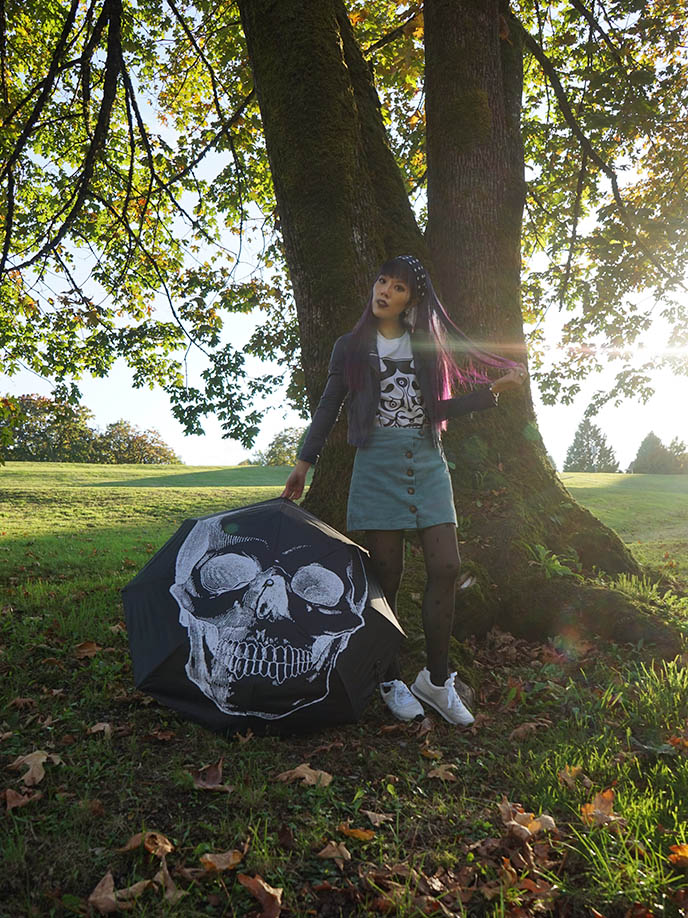
When leaves hit the ground, the veil between the living and the dead is at its thinnest… and I am in my element.
Happy October, everyone. I’ve missed the fall so much!
I have several Halloween tricks and treats for you, including a major trip…
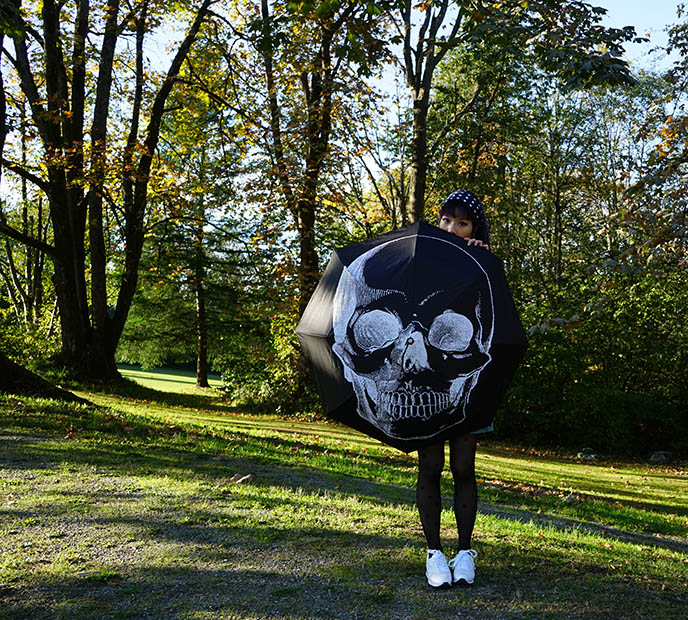
My skull umbrella from Raven Goods is a hint at where I’m heading at the end of October.
I’m thrilled to announce that I’ll be celebrating Day of the Dead in Mexico, on a cultural tour with Borderline Projects and Morbid Anatomy! I can’t wait to share our Yucatan journey, which includes intimate encounters with the brushing of the bones, and Dia de Los Muertos.
Scroll to the end of this post for the full info about my deathly travels in Mexico, and how you can join next year’s adventure.
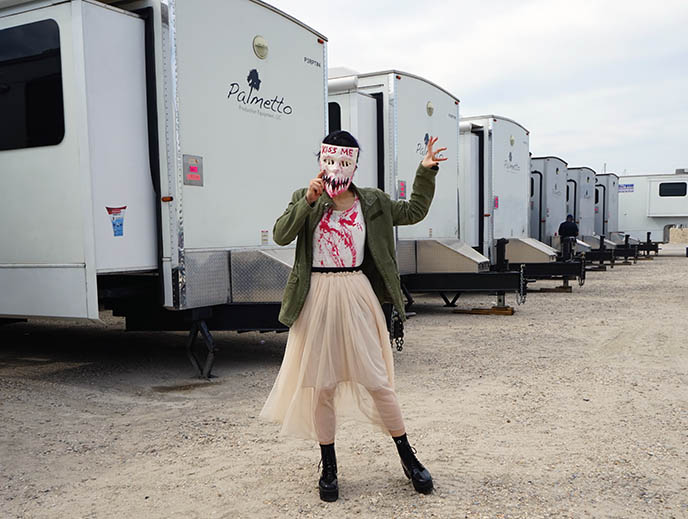
I’ll also give you a teaser of my Purge TV show adventure: I’m making a little cameo in the finale episode. (Above: I had the hardest time figuring out which one was my trailer…)
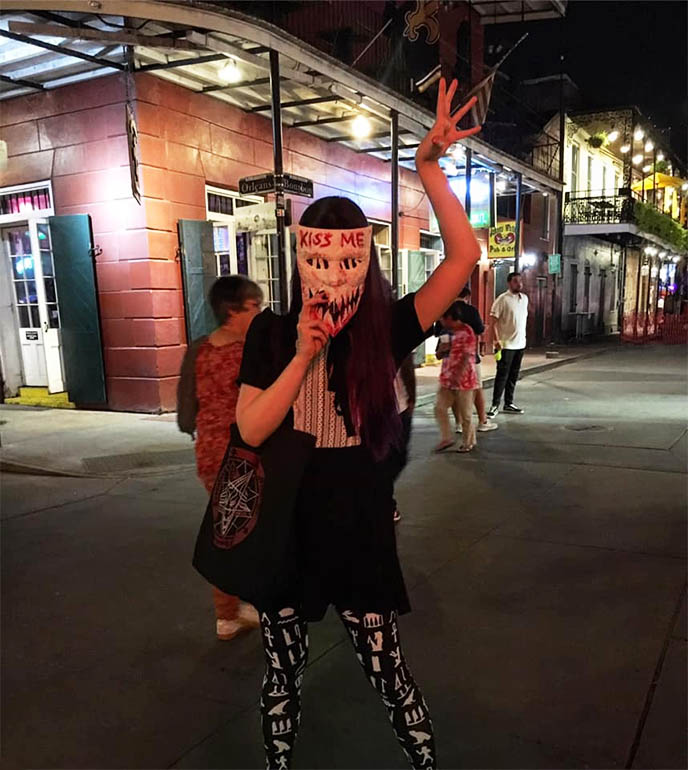
Blumhouse Productions and USA Network flew me to New Orleans, so I could get a behind-the-scenes look at the TV production. In our downtime, we did a little purging on Bourbon Street!
Keep reading to see my exclusive set visit, and… new tattoos??
(Season two of The Purge TV show begins airing October 15, on USA Network. I’m in the tenth / last episode.)
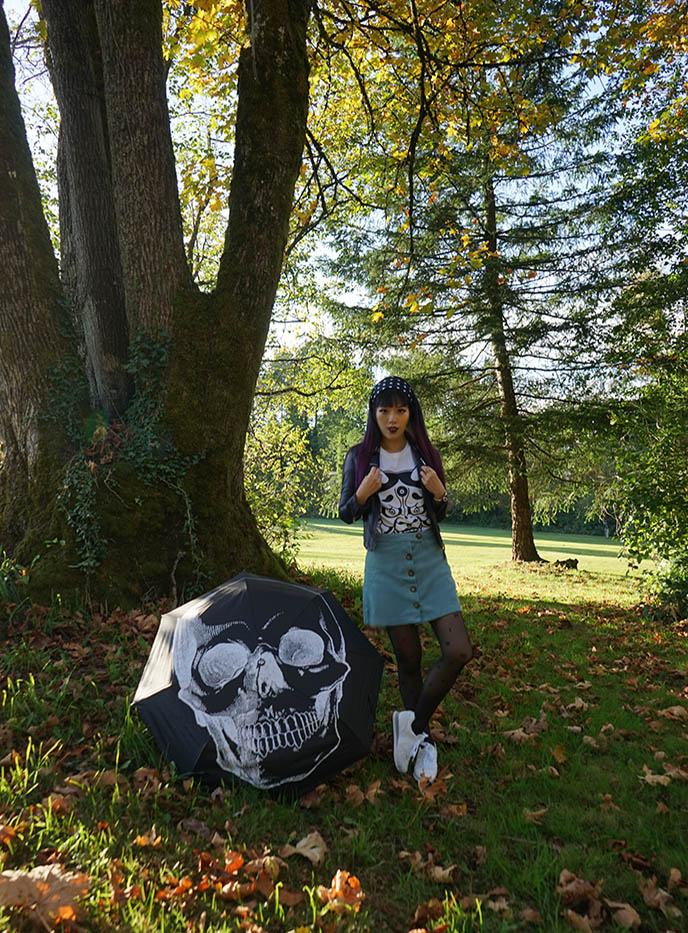
First, let’s welcome the spookiest time of the year with some devilish outfit photos.
OOTD: Goth umbrella Raven Goods, demon tee 1991NewYork, corduroy skirt Forest Ink, stockings UK Tights, hair scarf and sneakers Lola Ramona.
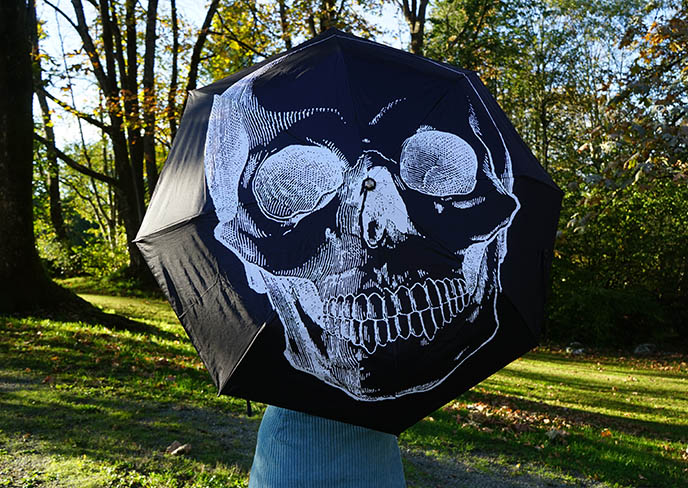
Isn’t this grinning cranium umbrella fabulous? It’s my new favorite accessory, from indie Goth boutique Raven Goods.
Raven Goods has a magnificent curated selection of items in black or dark tones: perfect for creatures of the night like ourselves. Their web shop includes dark and Gothic home decor, jewelry, and crystals.
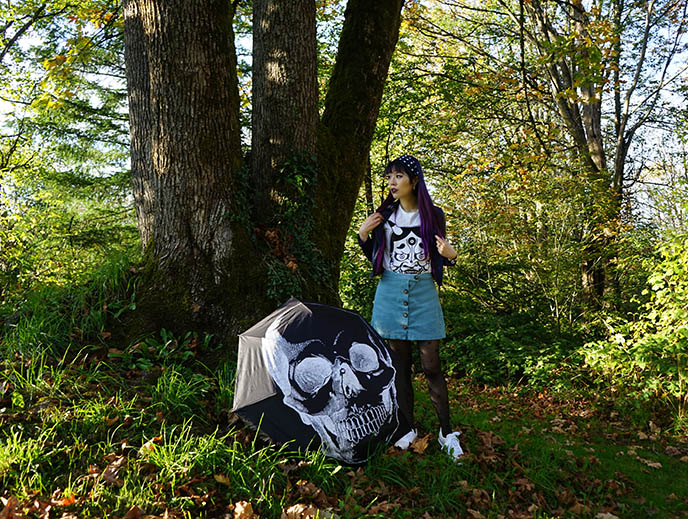
I’m all about supporting small businesses like Raven Goods, which is owned and operated by a husband and wife team. Their dark fashion and home design products are offered at reasonable prices, and they give friendly and fast personal support to their customers.
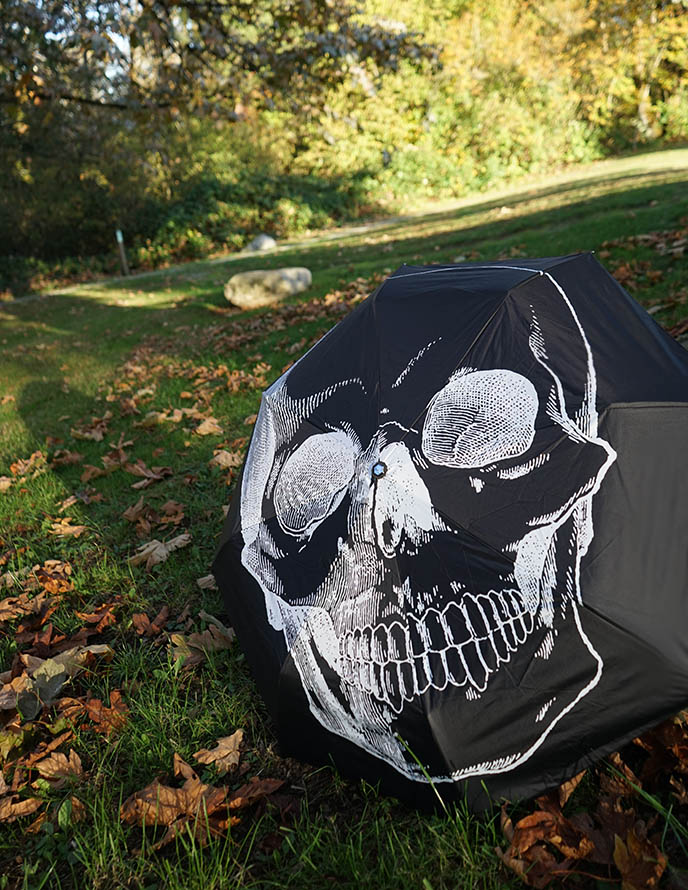
I love the reflecting crystal in the center of the skull (it looks a bit like a nose ring). The retractable umbrella is perfect for traveling, and doubles as a parasol: the black SPF fabric protects you from the sun.
Take a peek at RavenGoods if you fancy items like Victorian anatomy plates, Rococo Gothic bedding, ram’s head rings, and dark angel wing earrings.
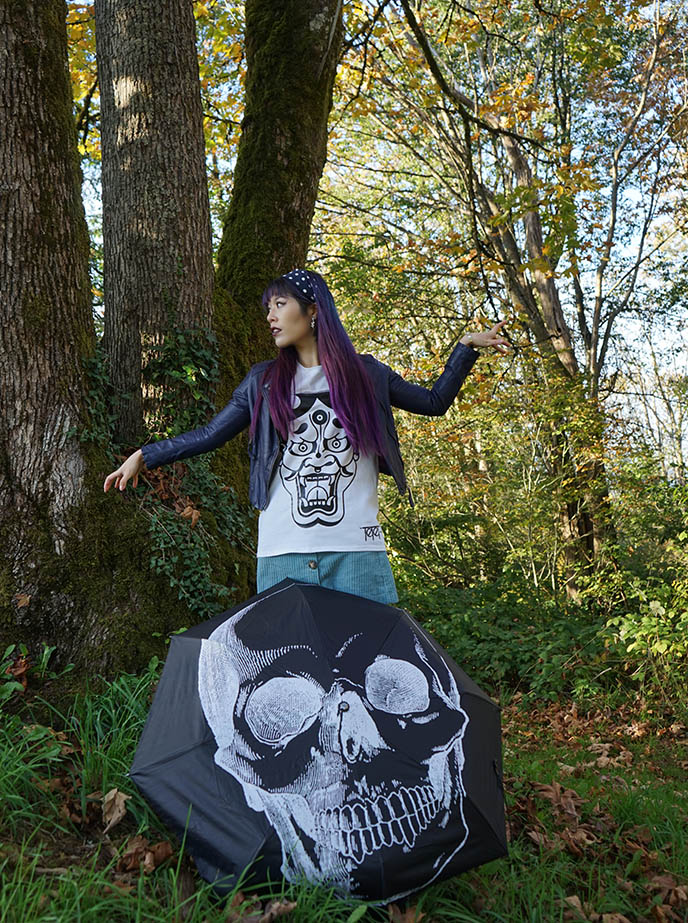
My scowling Japanese devil mask top is by 1991NewYork. It’s actually a Hannya, representing a jealous Shinto female demon!
1991 New York is a streetwear brand by NY tattoo artist Hiten Damodar. His screen printed tees are 100% cotton and made in the USA, and feature his tattoo designs based on mythology. (You can see more of his striking designs on his site.)
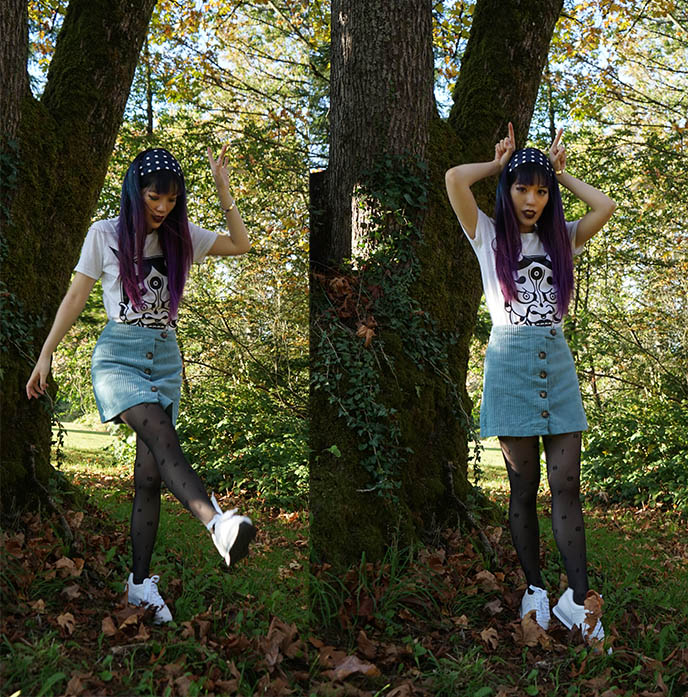
How do you like my “white demon” look of the day? As you can see, it’s possible to do a Gothic look without wearing black.
This is also an example of how to style white sneakers with an outfit.
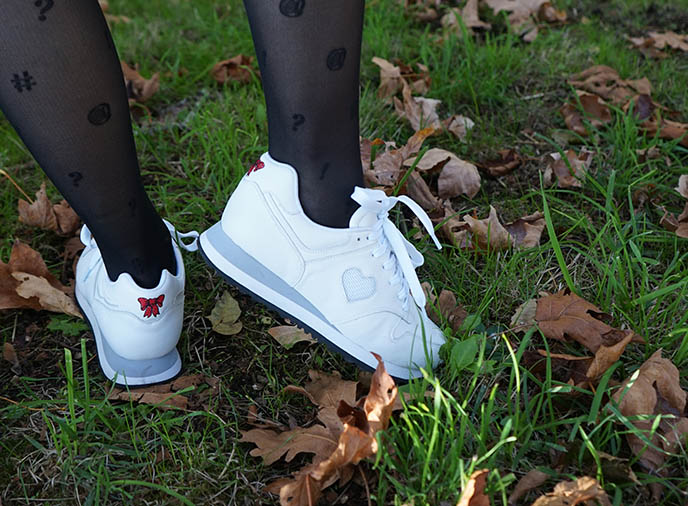
Lola Ramona sent me these Serena Bullseye white leather sneakers, and they’re the cutest kicks I’ve ever seen. In love with the mesh heart on the sides, and red ribbon design in the back. The bouncy sole and comfortable lace-up style makes these sneakers perfect for fall walks.
I matched them with Lola Ramona’s retro polka dot scarf, which I wore as a headband. My stockings with keyboard symbols is by UK Tights.
Click the thumbnails below for more shoe styles from Lola Ramona:
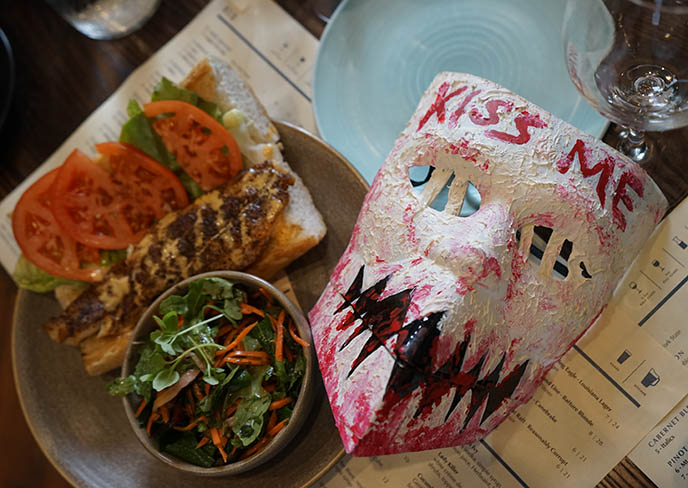
Now, let’s talk about NOLA! I was invited along with several other journalists to visit the set of The Purge TV, which was shooting its second season after a successful debut.
Before flying to New Orleans, I felt inspired to put together a Purge cosplay. Using caulking and paint, I DIY-ed a Kiss Me mask like the one worn by Kimmy the Candy Girl, in “The Purge: Election Year” movie.
My mask and I sat down to delicious New Orleans lunch: blackened cod po’boy and salad. On this press trip, I got my fill of grits, mahi mahi, gumbo, catfish, and Sazerac cocktails… but boy, are portion sizes immense in the South. Ironically, I was so full from these meals that I was close to Purging!

Quite fittingly for a horror television show, The Purge (season 2) is shot in New Orleans. Many of the new episodes make the most of the city’s spooky vibe.
I hadn’t been in New Orleans since my first visit in 2014, and it felt great to be back right before Halloween. We only had a few days here, but it was enough to explore a few spots — like Marie Laveau’s House of Voodoo.

With its vampire and voodoos connections, New Orleans is one of the Goth-est cities on the planet.
For more travel tips, see my NOLA Gothic guides from my previous trip. I covered the graveyards, haunted places, alternative nightlife and art galleries, you name it.
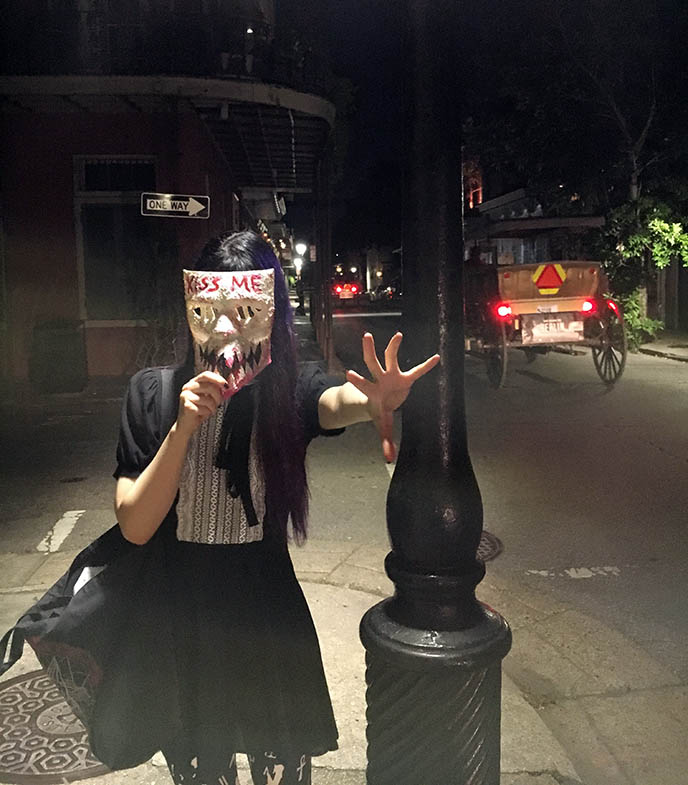
I’ve got the urge to purge…
Horror fans will be familiar with The Purge movies by Blumhouse Productions. In this universe, once a year for 12 hours, pretty much all crime is legal.
Some citizens love the annual bloodbath, and get creative in the ways they commit murder. Others hide in fear, or fight against the “New Founding Fathers” that implemented the Purge.
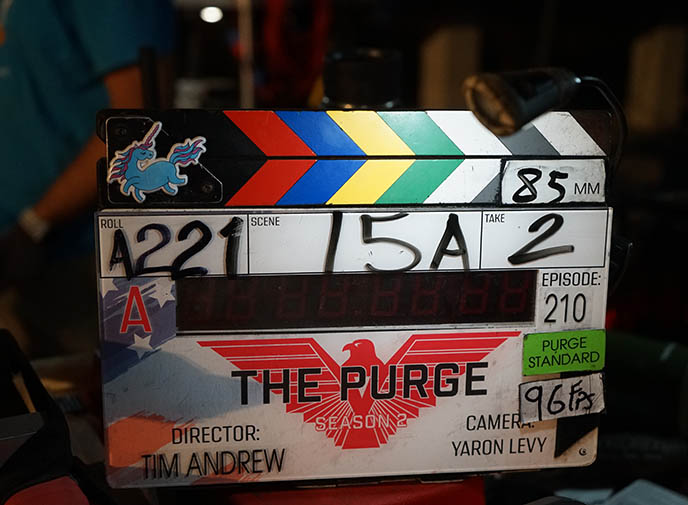
The Purge is now also a highly-rated TV show. The second season follows several characters in a year between the Purges, leading to intertwined storylines. I’ve watched several episodes of the new season so far, and it’s bloody fantastic — better than the first, IMO.
As an invited journalist, I got to go on set while The Purge was filming, and meet the actors and crew. I can’t reveal any spoilers, but soon, I’ll give you an inside look at the masks, daring stunts and more.
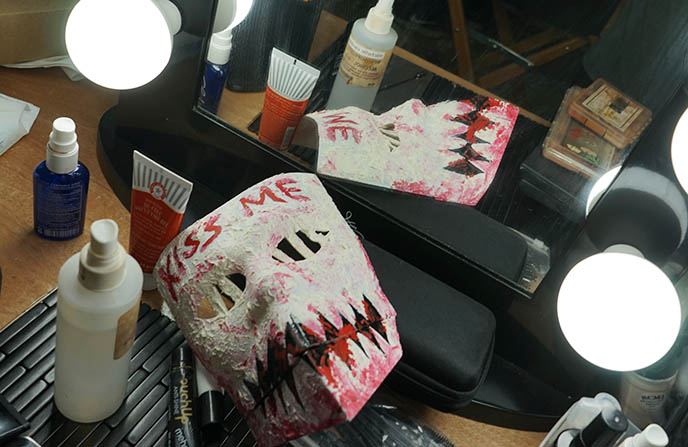
I also got to be an extra in the final episode, in a scene with actors Derek Luke and Rochelle Aytes! (They play a husband and wife whose perfect life is shattered when an assassin breaks into their house on Purge night.)
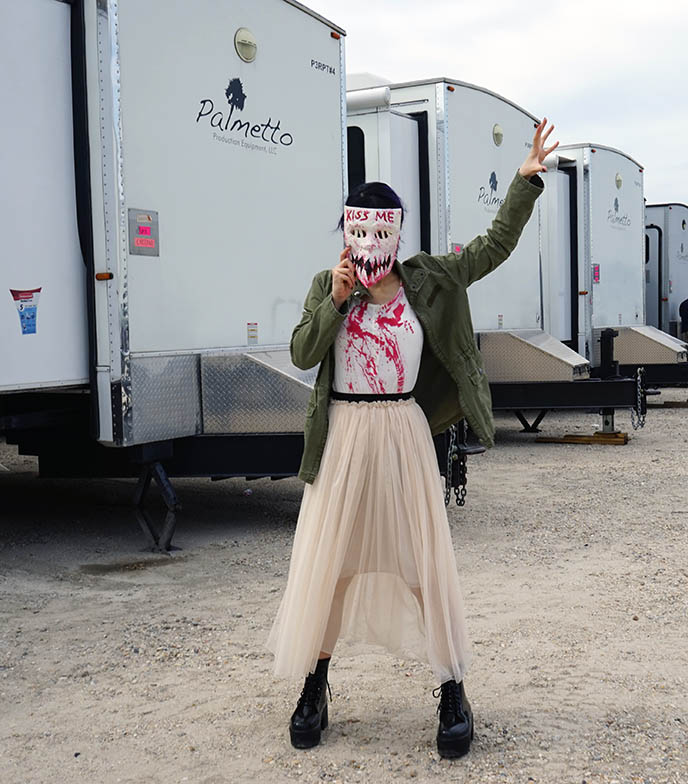
My lips are sealed when it comes to exactly what I do in my appearance on The Purge TV show. You’ll just have to wait until the last episode for my big scene…
However, I can show you this “Kimmy the Candy girl” costume I put together, in tribute to the evil schoolgirl from The Purge: Election Year film!
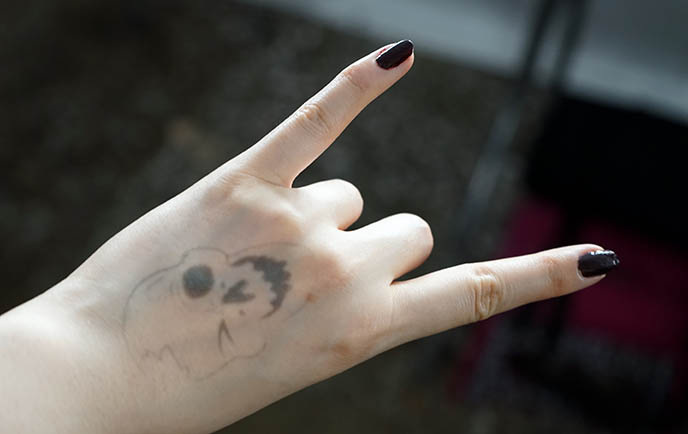
Here’s a wink. I got to wear fake tattoos for my scene in the Purge TV finale!
The makeup artist put this temporary skull tattoo on my hand. I told the crew they could go wild with my hair and makeup, and so they did, as you’ll see…
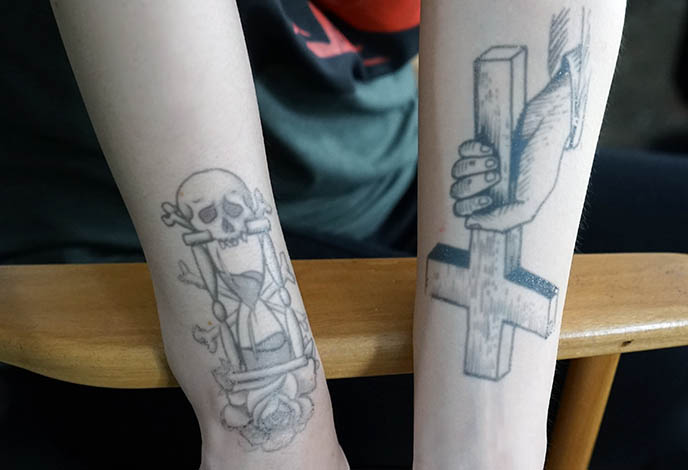
I made sure this crucifix tattoo was upside down. So much fun to embody a different character, and have giant Gothic tattoos for a day.
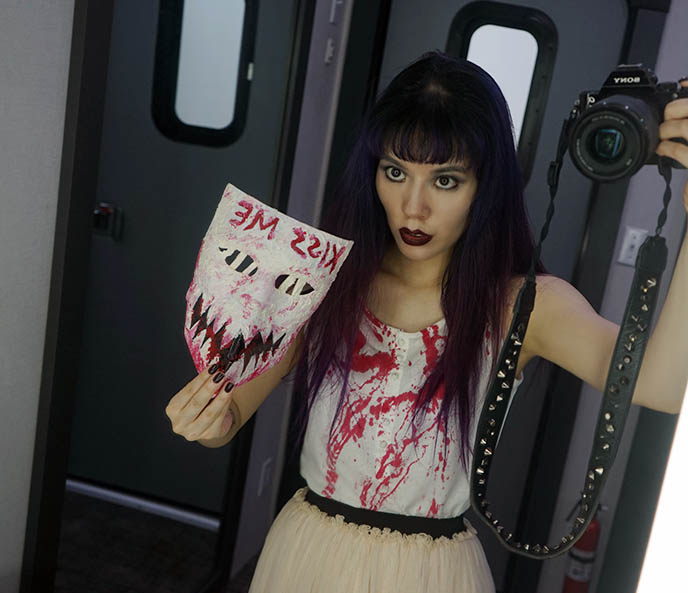
Here’s another look at my Kiss Me mask, and Purge Election Year candy girl outfit.

Compare my cosplay to the character in the Purge movie, above. I think it turned out quite bloody well!
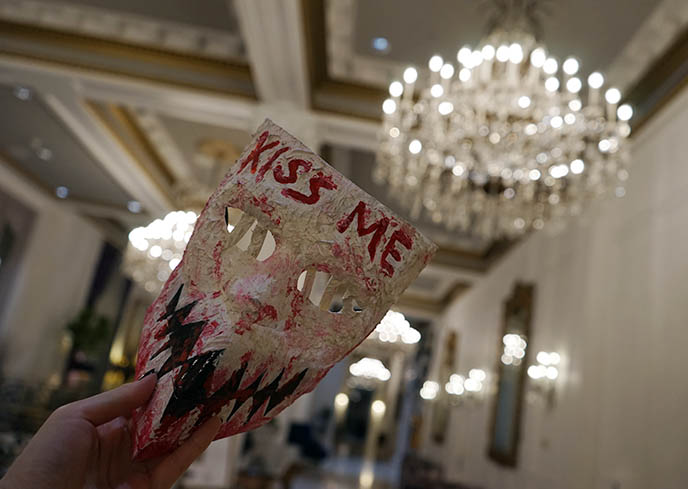
“This is your emergency broadcast system announcing the commencement of the Annual Purge.”
The Purge TV show (season 2) starts airing Oct 15 on USA Network. Give it a watch; I assure you that you won’t be disappointed. (And you can see me on-screen in the final episode, which will be broadcast Dec 17 at 9pm ET.)
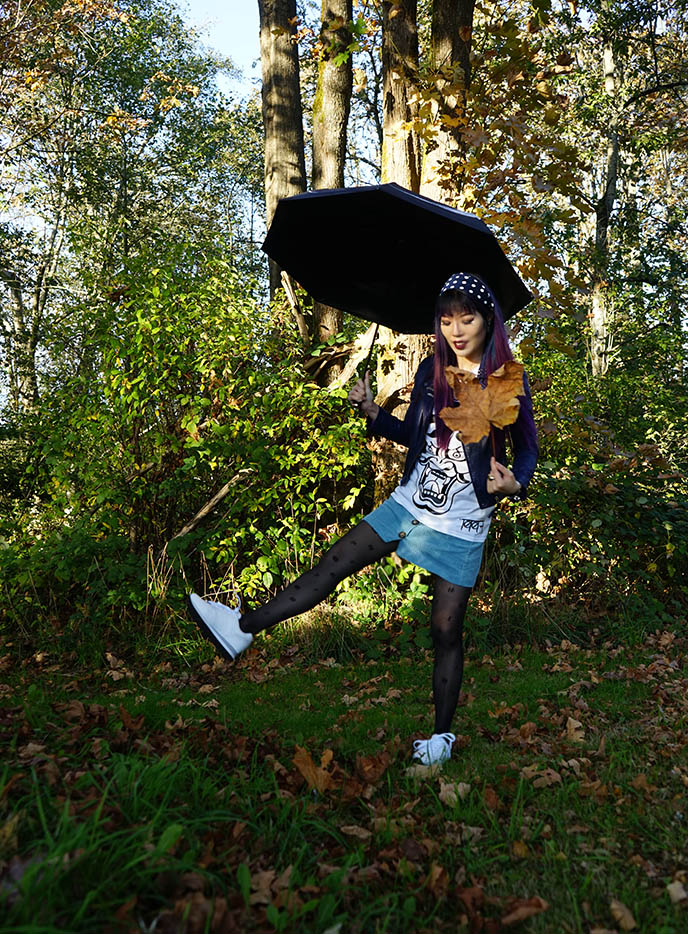
I think you can tell I’m loving Halloween season… Next, I can’t wait to celebrate Day of the Dead in Yucatan Peninsula!
Every year, Borderline Projects and Morbid Anatomy offer a curated tour that lets you experience Dia de los Muertos traditions with local communities in Mexico.
I’m joining this year’s Mayan Rebirth trip, which will take me to Merida, Campeche, and surrounding areas. Take a peek at our 4-day Mexico itinerary: it includes a “Food for the souls” ritual, a “Festival of the Souls” celebration in a cemetery, and a “Cleaning of the Bones” ceremony in a small town.
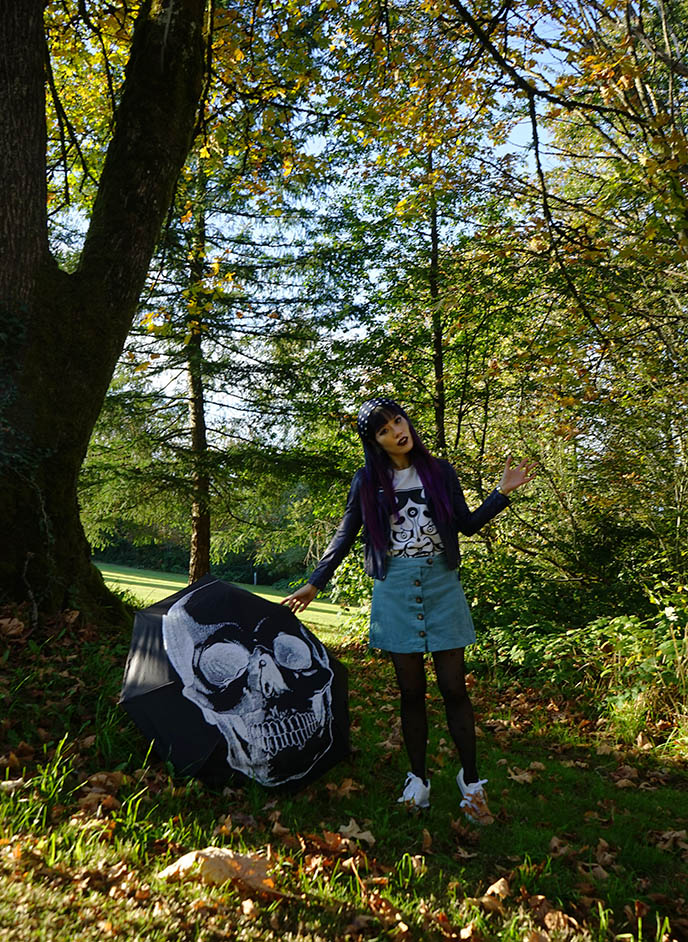
Gracias to Borderline Projects for inviting me to take part in this Death In Mexico travel series; I can’t wait to learn first-hand about Mayan rituals and folk traditions.
This year’s tour is sold out, but there is already a RSVP list open for the 2020 edition. You can email info@borderlineprojects.com for more info and to reserve a spot for next year.
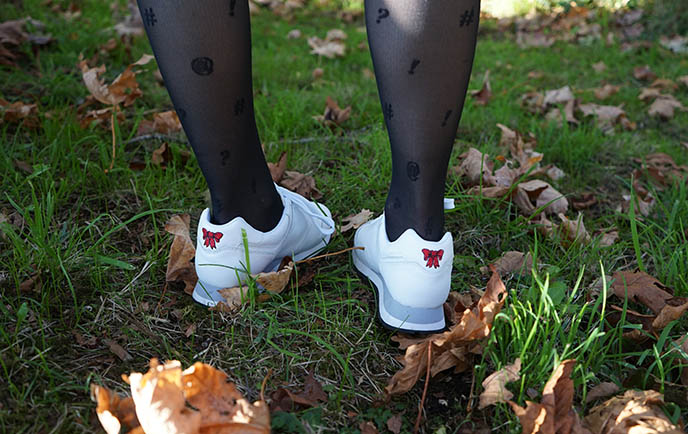
A last look at my nylons from UK Tights, and cute white leather sneakers by Lola Ramona. (See more shoe styles below from this designer.)
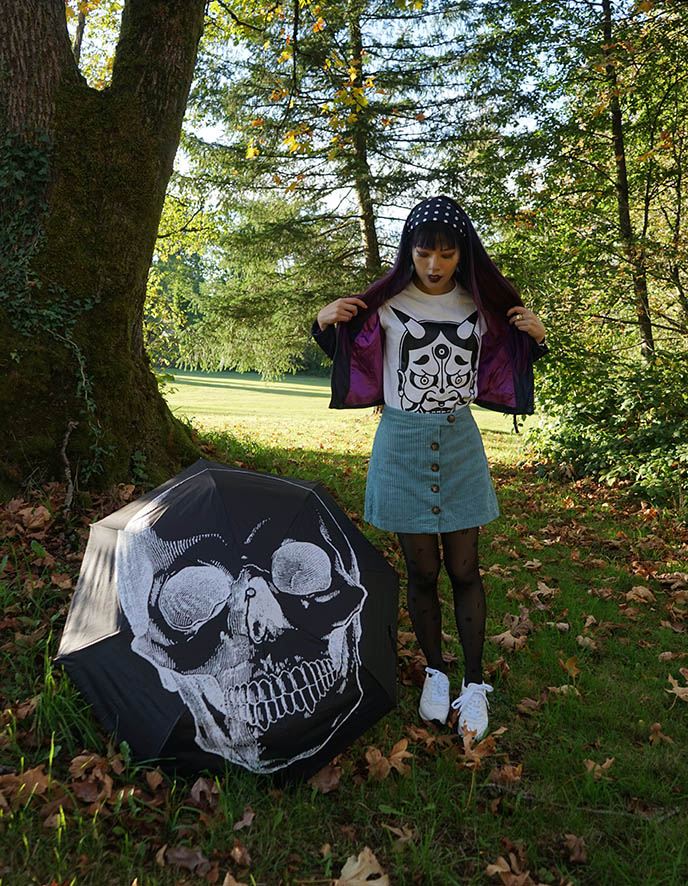
Can’t wait to get my hands on more Mexican sugar skulls!
(Gothic umbrella Raven Goods, skirt Forest Ink, hair scarf Lola Ramona, Japanese tattoo t-shirt 1991NewYork).
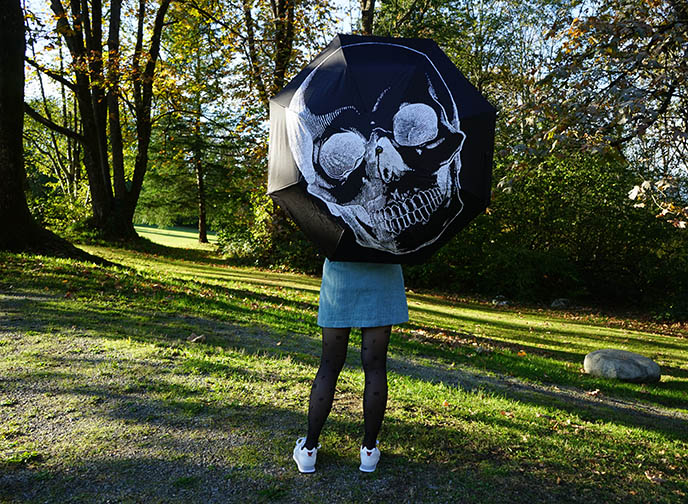
Stay tuned to my Instagram/Twitter @lacarmina to see my adventures in Yucatan for Halloween and Day of the Dead. I also invite you to add Salvador Olguin & Borderline Projects on Facebook, Instagram and Twitter for updates on their cultural journeys.
I’ll be stopping in Mexico City as well, so please let me know if you have any travel tips for me. See you at Dia de los Muertos… and watch out for The Purge!
SHARE & COMMENT
Goth guide to Paris! Visiting the Catacombs skulls, Pere Lachaise Gothic vampire cemetery, Cantada II absinthe bar.

Kiss Me… if you want to get Purged!
Can you tell I’m already in a Halloween mood? I’m relieved that scary season is back — I always feel most “me” at this dark time of year.
To celebrate, I’m sharing my Gothic travel guide to Paris, France — including a visit to the Catacombs and famous Pere Lachaise cemetery.
And I also have a fun announcement… Blumhouse Productions is flying me to New Orleans, to be part of the Purge TV show and report from the set!

I’m sure you’ve heard of Blumhouse, as they’ve released some of the most terrifying horror movies in recent years. I’m a huge fan of The Purge, Paranormal Activity, Get Out, Insidious, Split, Happy Death Day, and the new Halloween (with music by John Carpenter, godfather of synthwave!)
Right now, Blumhouse and USA Network are filming season 2 of The Purge TV show (one night a year, society becomes lawless — so you can pillage, kill and Purge to your heart’s delight). They’re flying me to New Orleans, where the series is being shot, to go behind the scenes. I’m also going to be in an episode, as an extra: you’ll see me in a big finale scene.

(I got so excited about this opportunity that I decided to cosplay as Kimmy, the evil candy girl from “The Purge: Election Year!” She wears this bloody “Kiss Me” mask as she wreaks havoc. I took a plain white masquerade mask, and covered it in white caulking, paint… and real blood?)
Ready for the Commencement? You’re invited to follow along my Instagram @lacarmina to see my horrific adventures in New Orleans, with The Purge TV show!
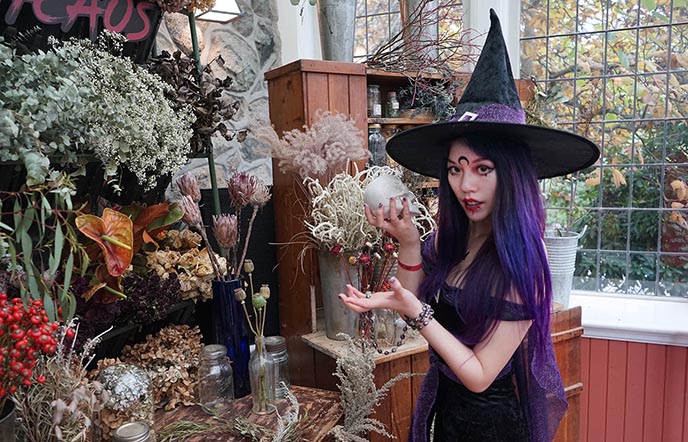
I’ll also be visiting Boston and Salem, MA — center of the 17th century witch trials. Can’t wait to get my Witch on, in one of the most Gothic places in the world. Keep your eyes peeled for stories from Salem, a place I’ve wanted to see for years. (Photo from last year’s Netflix Spellman House for the Chilling Adventures of Sabrina TV show.)
And I have two more trips coming up in October… I’ll reveal more soon. This is going to be the best Halloween ever, muahaha.

Until then, I’m thrilled to release my Gothic travel guide to Paris, France!
Let me take you to the darkest, spookiest places in the city, including The Catacombs of Paris. (I know many of you have been asking me to cover this ossuary, for years.) We’ll encounter thousands of human skulls and bones…

… and hunt for bats and vampires in Père Lachaise Cemetery. (Above is a devilish winged symbol I found on a tomb.)
Finally, we’ll unwind with a glass or several of absinthe, at Cantada II — the heavy metal absinthe bar that Anthony Bourdain visited.

Let’s begin our Gothic tour of Paris with a stroll through Père Lachaise Cemetery.
The Paris Tourism Board connected me with Jacques Sirgent, vampirologist and author. He also curates le Musée des Vampires, a collection of obscure vampire objects, and runs walking tours that show the darkest aspects of the famous graveyard.
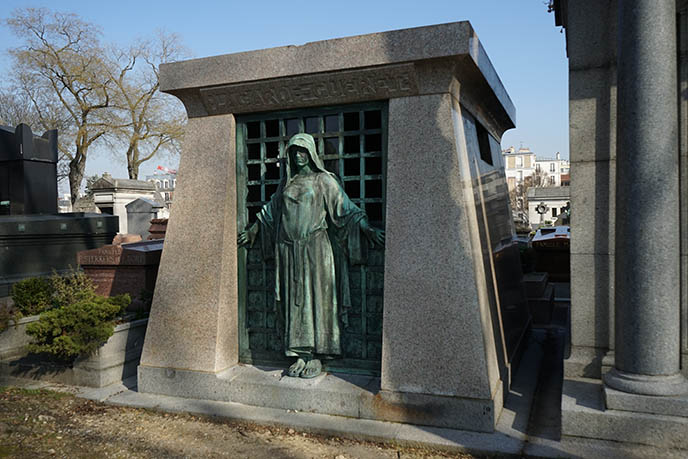
Père Lachaise Cemetery opened in 1804, and stretches over 110 acres. The burial ground is named after Louis XIV’s confessor, and is the final resting place of many famous artists — including Melies, Proust, Moliere, Ingres, and Jim Morrison.

Jacques Sirgent knows every corner of cemetery, and has uncovered its most haunting secrets. He showed us desecrated graves — like this one, with Jesus’ arms removed — and places where he found the remains of twisted, occult rituals.
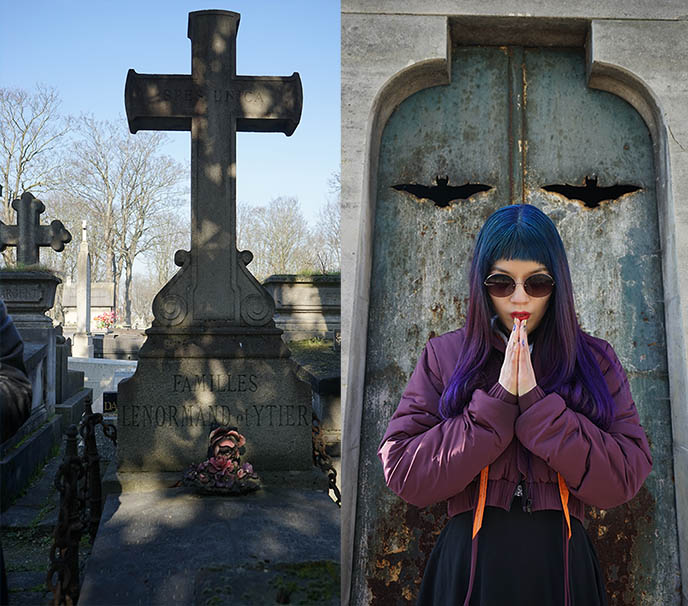
Pere Lachaise is a Goth wonderland. We wandered past decaying flowers under stone crosses, and mausoleums guarded by bats.
(My silk cropped jacket is by Charli Cohen).

Jacques pointed out dark details, such as this figure with what appear to be horns and batwings. The 19th century French mausoleums are beautiful to behold.
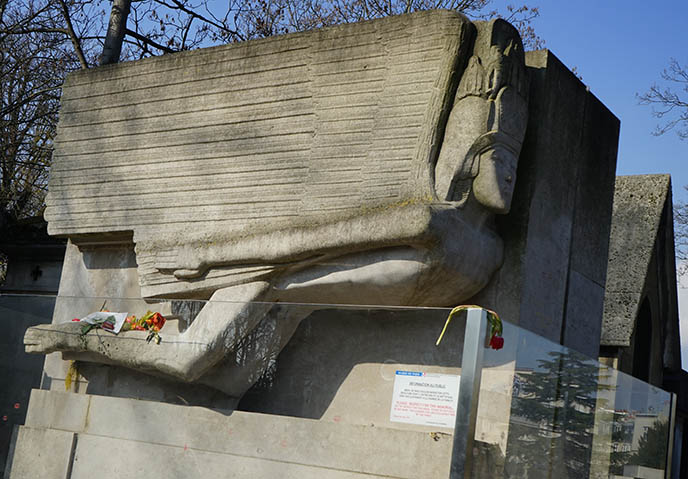
Don’t miss the grave of Oscar Wilde, featuring a 1914 sculpture by Jacob Epstein. This winged deity in motion is inspired by Wilde’s poem The Sphinx. (Officials had to put up a glass barrier, as too many people were kissing the stone).

Jacques told us tales of his strange discoveries and theories at Pere Lachaise. He suggests that this coffin-shaped grave for Leduc is linked to Vlad Tepes, the real Count Dracula. Fittingly, it’s marked with bats, always in the dark, and has no cross.
(I’m wearing a Jolie dress by Parisian designer Valfre.)

If you’re visiting Paris, be sure to wear your finest mourning garments, and hunt for bats and vampires at Père Lachaise.
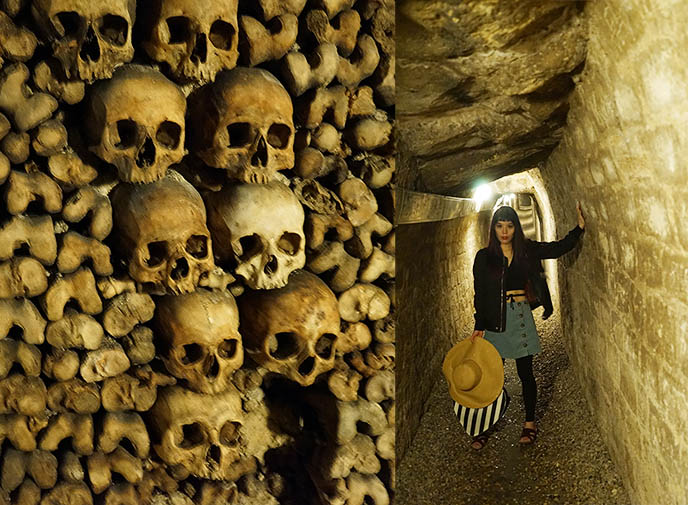
For a more morbid attraction, you’ve got to make a pilgrimage to the Catacombs of Paris!
The catacombs can only hold 200 visitors at a time; book a ticket online in advance, or arrive at off-hours to avoid waiting in a long line. A head’s up: you have to walk down 131 steps, and up 112 at the end, so the site may not be accessible for everyone.
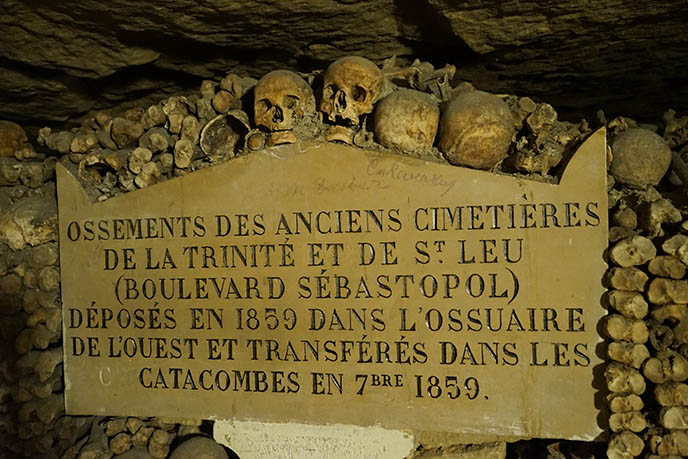
It doesn’t get any spookier than this subterranean collection of the dead. The Paris Catacombs hold the skeletal remains of more than six million people!

In the late 1700s, Paris’ cemeteries were over-crowded, and rotting corpses were spilling out. As a solution, officials unearthed, blessed, and stacked mounds of bones in the city’s former limestone mines.
The Goths of the 19th century enjoyed hanging out in this bone repository, as you can see in the drawing above.
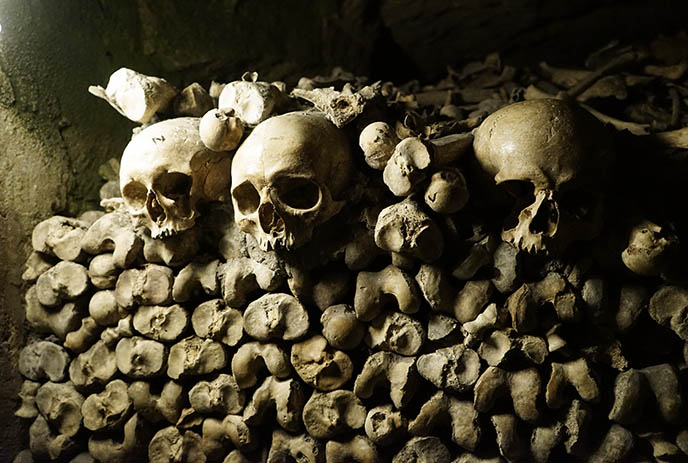
As you creep through the Catacombs, you’ll be surrounded by tall stacks of skulls and bones. I felt quite at home among the dead, but the “dry random bits” at the top made me shiver.

“Dem bones” are rather artfully arranged. Just when you think you’ve reached the end of the tunnel, you’ll step into yet another passage filled with femurs and crania.

I learned that only a small area of the Catacombs are open to the public. Some urban explorers known as “Cataphiles” illegally sneak into secret entrances, and hang out in the dangerous restricted zones.
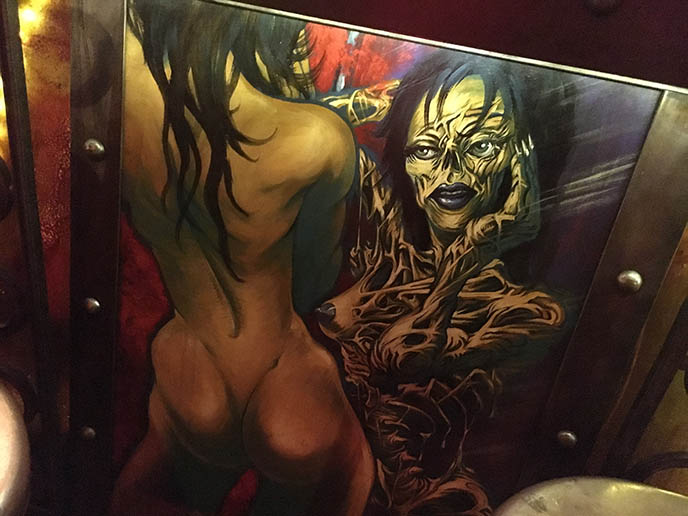
The ghoulish theme continued that evening at Cantada II, a heavy metal absinthe bar in the 11th arrondissement.
I learned of Cantada II from Anthony Bourdain’s Paris episode (RIP). With blood red walls, and creepy zombie / monster art everywhere, this was my kind of place.

Cantada II has dozens of absinthe bottles from around the world, which you can order on the rocks, in a cocktail, or served with a flaming sugar cube and water drip from a vintage vessel.
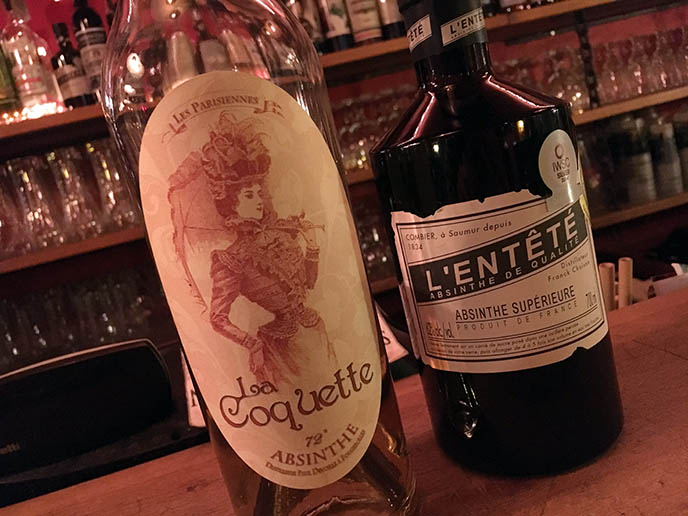
Don’t expect a ritzy fin-de-siecle environment: Cantada II blasts heavy metal music, and draws in a gritty alternative crowd.
Since I was in Paris, I stuck to French absinthes including La Coquette, and L’Entete. Everything is well priced, and there are beers and spirits as well.

Creep past the viking skeleton, and enter a crypt that doubles as a performance space. You might encounter burlesque, pole or tribal dancers at “Cabaret du Neant,” or hipster singing hard rock karaoke.
So happy I got to experience Cantada II absinth bar, and all these spooky sites, while traveling in Paris.

Since I’m in a Halloween mood, we’ll end with a few “batty” outfit posts that I hadn’t shared on the blog. Sourpuss Clothing sent me this Gothic bat baseball tee, faux fur leopard print jacket, and black mini-skirt.

I paired it with a bone-shaped hair clip, Jeffrey Campbell platforms, and a Miffy purse from Hong Kong. (The Miffy lamp is from Mr Maria.)

This Sourpuss faux fur cheetah print jacket is a vibe, no? Love animal prints, and the motto on their long-sleeve top: Support your local working stiff, Monster Mortuary!
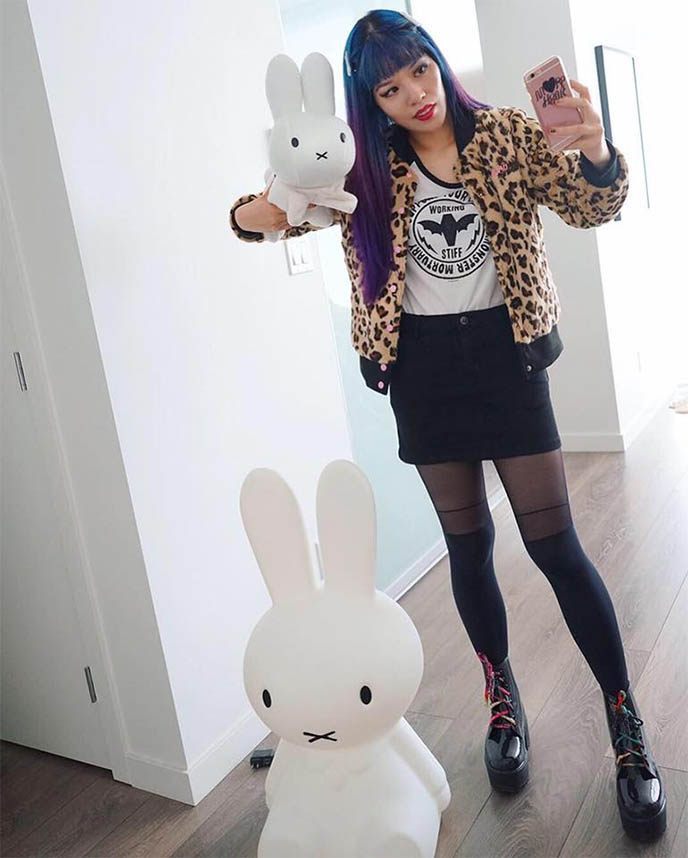
Release the bats… and bunnies! Here’s the head-to-toe look, which is perfect for fall weather (so happy it’s no longer so hot outside). Hail Miffy, my favorite cute mascot, as you well know.

This summer, I didn’t go anywhere without this Lack of Color bucket hat. The cotton-canvas material is light and foldable, and the black color matches everything. It’s perfect for taking along on a day out, and can be worn with the brim pushed up or down.

What I wore to see Perturbator in concert. Top by Turboluv, a synthwave / outrun / retrowave clothing label. The pharoah leggings are by Cryptic Apparel.
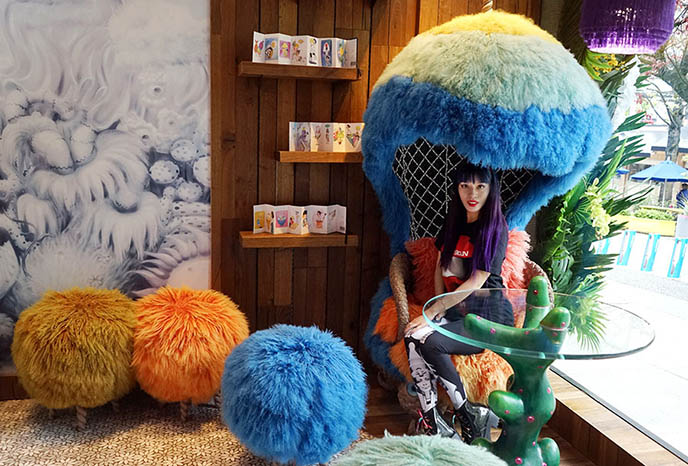
I paid a return visit to the Laurence and Chico cafe in downtown Vancouver. This time, I got to sit in a different fuzzy critter chair in the whimsical high fashion cafe.

I also checked out Hail Mary’s Vancouver, a kitschy theme bar with sacrilegious cocktails and Virgin Mary decor all over.

Adieu to Paris for now… here’s a final look at the Arc du Triomphe, lit up at night.
I hope you enjoyed my spooky, alternative guide to the city. For other tips (including museums, where to stay, and what to eat), you can consult my first Paris travel article here. A bientot, Paris.
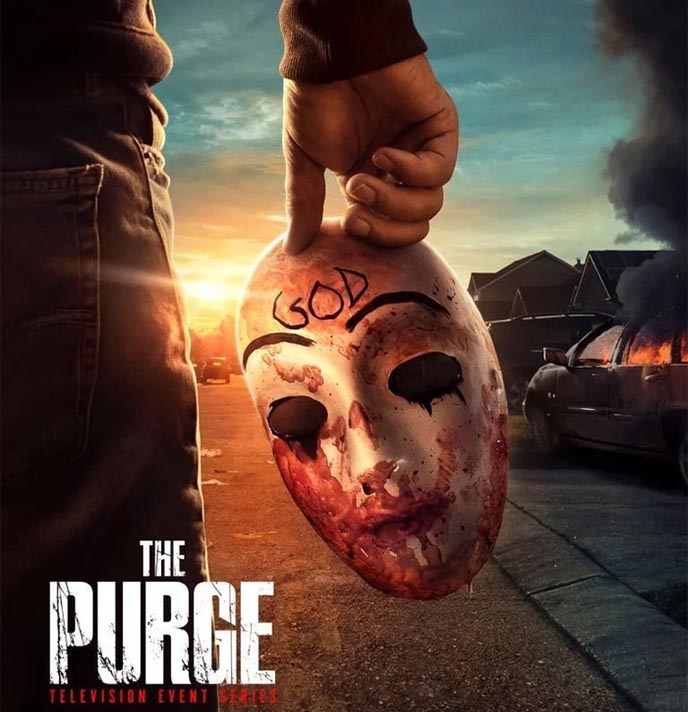
“This is not a test.” I’m truly off to get Purged!
Check out my Instagram @lacarmina posts and stories starting today, to see what I get up to, on the set of The Purge TV show in New Orleans. It’s going to get bloody… and you’re going to love every second of it.

 LA CARMINA
LA CARMINA






